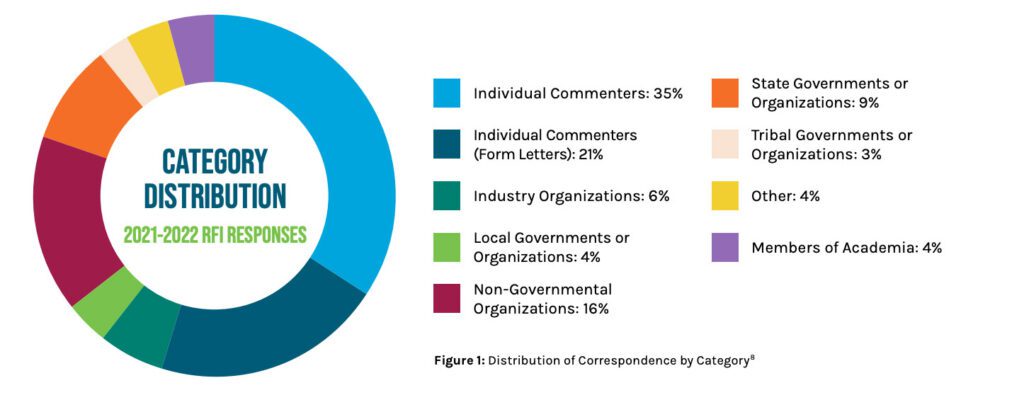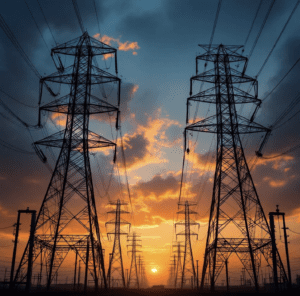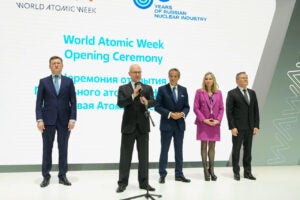The Department of Energy (DOE) has initiated community outreach to facilitate consent-based siting, management of spent nuclear fuel (SNF), and interim storage facility siting. The effort, outlined in a series of steps the DOE expects to take in response to a recent request for public input, marks a significant first step toward advancing the agency’s long-paralyzed integrated nuclear waste management strategy.
The agency on Sept. 20 launched a $16 million funding opportunity announcement (FOA) to provide communities interested in learning about its consent-based siting process. The consent-based process champions siting the nation’s nuclear waste facilities with specific attention to the “needs and concerns” of people and communities.
The funding will go to six to eight awardees from academia, tribal, state, and local governments, community foundations, and non-governmental organizations. Awardees will operate over 18 to 24 months as “information, engagement, and resource hubs” to advance mutual learning within a community, provide ease of access to information, and foster open discussions, the DOE said. The agency envisions that awardees (or consortia) will pursue critical tasks, including organizing and maintaining “meaningful, inclusive community engagement processes” related to the management of SNF, and identifying public values, interests, and goals that enable effective community collaboration. As significantly, the awardees will also “provide direct grants to interested communities to ensure participation and remove barriers,” it said.
“While DOE is not soliciting volunteer sites to host consolidated interim storage facilities as part of this funding opportunity, the Department hopes to encourage engagement, open dialogue, and building capacity among interested stakeholders and communities about the consent-based siting process,” the agency said in a statement.
DOE Unveils RFI Comments, Next Steps in Comprehensive Report
The FOA follows the DOE’s formal revival in November 2021 of a consent-based siting process for nuclear waste, which the Obama administration’s Blue Ribbon Commission recommended in 2012. While the DOE issued a draft consent-based siting process for a consolidated interim storage facility (CISF) and a disposal facility for SNF and high-level radioactive waste on Jan. 12, 2017 (a few days before the start of the Trump administration), tangible action on the measure lapsed again until the Biden administration issued a request for information (RFI) on Dec. 1, 2021. The RFI sought public input about the consent-based siting process, the role of interim storage as part of an “integrated, national waste management system,” and how the administration could remove barriers to meaningful participation. The DOE said responses to the RFI would ultimately inform development of a consent-based siting process, an overall strategy for an integrated waste management system, and possibly result in a funding opportunity.
The DOE on Sept. 15 issued a report summarizing the 225 responses it received for the RFI. Comments came from tribal, state, and local governments, non-governmental organizations (NGOs), industry, academia, and individuals. Among the report’s key findings are that trust is a key challenge for consent-based siting. Commenters also overwhelmingly emphasized a need for a “fair process,” which would include two-way communication; early and sustained engagement with communities; flexible and inclusive processes; intentional outreach to marginalized groups; and attention to issues of access, transparency, and quality in the provision of information.
Commenters notably expressed concerns that consent could not be achieved in practice or that it would take too long. Some commenters urged the DOE to define consent, define who should give consent, and whether elected representatives should decide consent or lack of consent.
In a more surprising finding, more commenters expressed opposition to developing consolidated interim storage than those supporting it, citing concerns that “such facilities could become de facto permanent disposal sites given the lack of progress in developing a repository,” the report says. CISF supporters, meanwhile, noted a CISF would remove SNF from the nation’s existing nuclear power plants—“as a matter of fairness to communities that never agreed to the long-term storage of SNF at these plant sites”—and allow the DOE to meet contractual obligations and limit broader taxpayer liabilities.
As part of another notable theme, several commenters suggested Congress should update existing statutes and advance an implementable national plan for integrated nuclear waste management. Several commenters discussed amendments to the 1982 Nuclear Waste Policy Act (NWPA), while others urged establishing an independent waste management organization separate from the DOE.

Industry’s Burden: No Option But to Store Waste
Owing in part to a political deadlock in Congress, and the DOE’s decades-long default on a “standard contract” to begin disposing of SNF as required by the 1982 NWPA, more than 88,500 metric tons of commercial SNF and high-level waste is currently stranded at 76 operating and decommissioned reactor sites in 35 states. According to a September 2021–issued U.S. Government Accountability Office report, the volume of SNF grows by about 2,000 metric tons each year. Since 1983, about $54 billion has been credited to the Nuclear Waste Fund, including more than $21 billion collected from electric ratepayers, and more than $28 billion in interest that continues to accumulate at a rate of over $1.7 billion a year.
The DOE’s push to revive its long-stalled consent-based siting activities last year stemmed from the Consolidated Appropriations Act of 2021, which President Trump signed into law in December 2020. The law allocates $27.5 million to the DOE to carry out nuclear waste disposal activities, including as they relate to its development of interim storage activities. The law requires that at least $7.5 million be derived from the Nuclear Waste Fund.
“It has been more than 30 years since the enactment of the Nuclear Waste Policy Act (NWPA); more than 18 years since the federal government failed to meet its statutory and contractual obligation to begin removing used fuel from nuclear power reactor sites; more than seven years since the Yucca Mountain license application review process began; and more than five years since the Obama Administration defunded the repository program and dissolved the Office of Civilian Radioactive Waste Management (OCRWM),” said the Nuclear Industry Council, a business consortium advocate for new nuclear, in comments filed in response to the RFI. “The current estimate of federal liabilities is approximately $24 billion and growing—a $10 billion increase since the Obama administration first moved to terminate the Yucca Mountain project. In addition to these mounting costs, failure to bring closure to the backend of the nuclear fuel cycle adversely impacts nuclear energy as a much-needed component for low carbon, reliable and affordable electricity.”
The group said one solution would be to re-establish the OCRWM. It also said the DOE should follow existing law, specifically the NWPA. “Moreover, there should be no retroactive application of any new siting processes for the Yucca Mountain Project or private-sector consolidated storage facilities currently progressing under the processes defined by existing laws and regulations. The DOE should appropriately focus on restoring stakeholder confidence in a stable, predictable, and durable process that is science-based and leverages the private sector for implementation,” the group said.
Ellen Ginsberg, senior vice president, general counsel, and secretary for the Nuclear Energy Institute (NEI), a commercial nuclear industry trade group, said the NEI supports the DOE’s efforts to develop a consent-based process for siting CISF. “These efforts have the potential to build on the industry’s successful use of innovative dry-cask storage technology to store used fuel safely and securely at sites in 35 states,” she wrote.
Industry’s storage of used fuel at 76 reactor sites around the country is “safe, but highly inefficient,” Ginsberg wrote. “Consolidating security, monitoring, and inspection efforts at CIS facilities would create significant operational efficiencies and reduce overall fuel management costs. In addition, by safely relocating robust dry-cask storage systems currently spread across 35 states, the country would appropriately begin to establish an integrated approach to used fuel management. This would start to ease the $1 million per day financial burden on U.S. taxpayers to compensate plant operators for damages caused by the government’s inaction and partial breach of contract.” She added: “Removing fuel from shutdown sites also would spur economic development by allowing for the redevelopment of nuclear sites that are fully decommissioned but for the continued storage of used fuel.”
A broad consent-based process, however, isn’t supported by private companies that set out to build CISFs, given the DOE’s inactivity. Holtec, a New Jersey–based energy industry equipment supplier that has proposed a CISF for SNF on a parcel of land owned by the Eddy-Lea Energy Alliance (ELEA) in Lea County and Eddy County, southeastern New Mexico, in a joint response with ELEA urged the DOE to recognize that a “one-size-fits-all consent-based process is both unnecessary and inappropriate.” Holtec noted that its proposed CISF, HI-STORE, “has the consent—through ELEA and its members—of the people who will be most directly affected.” While the Nuclear Regulatory Commission (NRC) in July issued a final environmental impact statement for the CISF, and recommended that no environmental impacts would preclude the NRC from issuing a license for environmental reasons, New Mexico has challenged the legality of the NRC’s proceedings.
“While DOE continues to look at other sites and perhaps other consent-based siting processes, we believe that the Department is in a position to determine that HI-STORE is an appropriate selection for a consent-based federal interim storage site,” Holtec and ELEA said. “The solution is before you in the form of the HI-STORE CISF.”
However, New Mexico Gov. Michelle Lujan Grisham, in comments filed in response to the RFP in March, emphasized that the state “remains firmly opposed” to HI-STORE and another CISF proposed in nearby Andrews County, Texas, by Interim Storage Partners (ISP). “The DOE’s effort to seek input on a consent-based siting process for federal interim storage facilities stands in stark contrast to the process currently underway for commercial interim storage facilities,” she said. In a letter to the DOE, New Mexico Cabinet Secretary James Kenney urged the DOE to ensure that the siting of any interim storage facility in the state—“irrespective of whether it manages federal or commercial SNF or HLW, must require concurrence from the current governor prior to issuing its license or permit to operate.”
DOE’s Next Steps: Acting With Urgency, Gaining Trust
The DOE in the report outlined a suite of “next steps” as part of its consent-based siting process for a federal CISF. First, it will work to implement “congressional direction in a way that maximizes the potential benefits of consolidated interim storage.” These benefits include “expediting the removal of spent nuclear fuel from existing plant sites; potentially reducing taxpayer liabilities for spent nuclear fuel management; providing economic development opportunities for willing and consenting host communities; and demonstrating key institutional and technical capabilities; with respect to consent-based siting,” it said.
A second crucial step involves “addressing the current deficit of trust in DOE by making changes internally and externally.” Internally, the agency is already working to follow through on commitments and “candidly acknowledge missteps,” it said. “Externally, DOE is embarking on a consent-based siting process that is inclusive, community-driven, phased, and adaptive,” it said.
Other steps will involve ensuring the process is “fair and inclusive,” putting community needs and well-being at the center of the siting process. Finally, the DOE will work to expand efforts to address SNF transportation issues and “rigorously applying safety, security, and other criteria in all aspects of the siting process, including by supporting communities that wish to conduct independent studies related to safety and other issues of concern.”
—Sonal Patel is a POWER senior associate editor (@sonalcpatel, @POWERmagazine).








